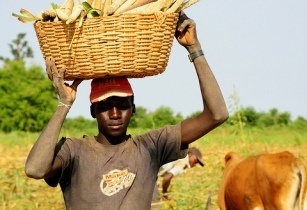Africa can leapfrog out of the deepening pit of poverty encompassing its socio-economic fabric, according to Professor Calestous Juma, a professor of international development at Harvard University
In Juma’s new book he illuminates three major opportunities that can transform Africa’s agriculture into a force for economic growth: advances in science and technology; the creation of regional markets; and the emergence of a new crop of entrepreneurial leaders dedicated to the continent’s economic improvement.
Entitled The New Harvest: Agricultural Innovation in Africa, the book comprises of case studies from within Africa and success stories from developing nations around the world.
It outlines the policies and changes necessary to promote agricultural innovation across the continent.
Disagreeing with the views on African agriculture outlined in the book, the author insisted that he is optimistic that Africa is in good stead to feed itself in one generation.
“The inspiration was to convey to the continent a positive message that we can feed ourselves. The focus of the book is the role of infrastructure in agricultural development. Poor investment in rural transportation, energy, irrigation, and telecommunications has affected sectoral growth. If you modernise infrastructure then you can move produce to markets,’’ Juma said, setting the pace of the interview with African Review.
“The New Harvest underscores the importance of global learning in Africa’s agricultural development. It offers new ideas for international co-operation on sustainable agriculture in the tropics,” Laura Chincilla, President of Costa Rica, observed.
The book first begins with identifying links between food security, agricultural development, and economic growth.
It shines a light on why Africa has lagged behind other regions in agricultural productivity and reviews major advances in science, technology, and engineering, identifying their potential for use in African agriculture.
This exploration includes an examination of local innovation as well as indigenous knowledge encompassing information and communications technology, genetics, ecology, and geographical sciences.
The book emphasises the convergence of these and other fields and their implications for African agriculture.
“There is urgent need to invest in agricultural research universities in order to move African agriculture forward. Research and training should be strengthened in order to achieve success. Boosting support for agricultural research is part of a larger agenda to promote innovation,” Professor Juma enthused.
It is important to provide an enabling infrastructure for agricultural development. Modern infrastructure facilities need to reflect the growing concern over climate change.
In this case, there is a need to design “smart infrastructure” to take advantage of advances in the engineering sciences as well as ecologically-sound systems design, according to Juma.
“Infrastructure promotes agricultural trade and helps integrate economies into world markets. It is also fundamental to human development, including the delivery of health and education services. Infrastructure investments further represent untapped potential for the creation of productive employment,” the book reads in part.
Human capacity is integral to agricultural development through access to methods of improving techniques, increasing production, and gaining the ability to transform the sector into an income earning endeavour, according to Juma.
“The main reason why we have such poor infrastructure is that we have not invested in the training of engineers. We need to invest in the development of engineering, including that related to agriculture,” Juma observed.
“The development of small and medium-sized enterprises (SMEs) has been an integral part of the development of all industrialised economies. This holds true in Africa. Building these enterprises requires development of pools of capital for investment; of local operational, repair, and maintenance expertise; and of a regulatory environment that allows small businesses to flourish,’’ the book stresses.
Regional integration is a key component of enabling agricultural innovation because it dismantles three barriers to development: weak national economies; a dependence on importing high-value or finished goods; and a reliance on a small range of low-value primary exports, mainly agriculture and natural resources.
“There is lack of commitment to agricultural development on the continent at the highest level. We need the involvement of heads of state in the sector’s co-ordination. This is the missing link that needs attention. More investment in infrastructure is necessary and agriculture should be placed at the centre of the African economic development agenda. Agricultural policies should be long-term and consistent. Only then would Africa be lifted out of poverty and sustainable development enhanced,” Juma advised.
The book explores the role of rapid technological innovation in fostering sustainability, with special emphasis on sustainable agriculture. It provides illustrations from advances in information technology, biotechnology, and nanotechnology.
In summary, the book explores the new economic vision underway for African agriculture by focusing on emerging opportunities such as renewing infrastructure, building human capabilities, stimulating agribusiness development, and increasing participation in the global economy.
Nawa Mutumweno
